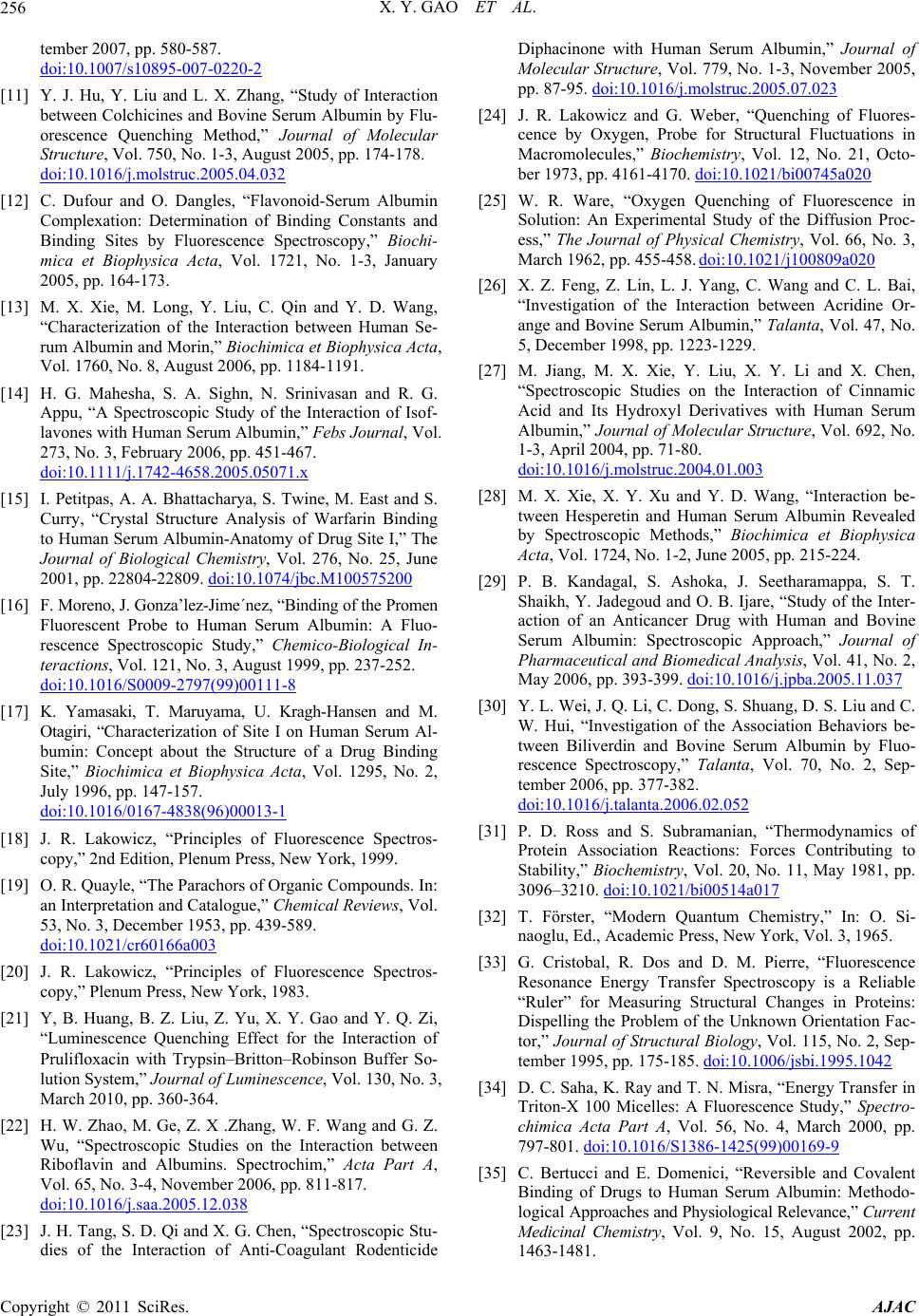
X. Y. GAO ET AL.
256
tember 2007, pp. 580-587.
doi:10.1007/s10895-007-0220-2
[11] Y. J. Hu, Y. Liu and L. X. Zhang, “Study of Interaction
between Colchicines and Bovine Serum Albumin by Flu-
orescence Quenching Method,” Journal of Molecular
Structure, Vol. 750, No. 1-3, August 2005, pp. 174-178.
doi:10.1016/j.molstruc.2005.04.032
[12] C. Dufour and O. Dangles, “Flavonoid-Serum Albumin
Complexation: Determination of Binding Constants and
Binding Sites by Fluorescence Spectroscopy,” Biochi-
mica et Biophysica Acta, Vol. 1721, No. 1-3, January
2005, pp. 164-173.
[13] M. X. Xie, M. Long, Y. Liu, C. Qin and Y. D. Wang,
“Characterization of the Interaction between Human Se-
rum Albumin and Morin,” Biochimica et Biophysica Acta,
Vol. 1760, No. 8, August 2006, pp. 1184-1191.
[14] H. G. Mahesha, S. A. Sighn, N. Srinivasan and R. G.
Appu, “A Spectroscopic Study of the Interaction of Isof-
lavones with Human Serum Albumin,” Febs Journal, Vol.
273, No. 3, February 2006, pp. 451-467.
doi:10.1111/j.1742-4658.2005.05071.x
[15] I. Petitpas, A. A. Bhattacharya, S. Twine, M. East and S.
Curry, “Crystal Structure Analysis of Warfarin Binding
to Human Serum Albumin-Anatomy of Drug Site I,” The
Journal of Biological Chemistry, Vol. 276, No. 25, June
2001, pp. 22804-22809. doi:10.1074/jbc.M100575200
[16] F. Moreno, J. Gonza’lez-Jime´nez, “Binding of the Promen
Fluorescent Probe to Human Serum Albumin: A Fluo-
rescence Spectroscopic Study,” Chemico-Biological In-
teractions, Vol. 121, No. 3, August 1999, pp. 237-252.
doi:10.1016/S0009-2797(99)00111-8
[17] K. Yamasaki, T. Maruyama, U. Kragh-Hansen and M.
Otagiri, “Characterization of Site I on Human Serum Al-
bumin: Concept about the Structure of a Drug Binding
Site,” Biochimica et Biophysica Acta, Vol. 1295, No. 2,
July 1996, pp. 147-157.
doi:10.1016/0167-4838(96)00013-1
[18] J. R. Lakowicz, “Principles of Fluorescence Spectros-
copy,” 2nd Edition, Plenum Press, New York, 1999.
[19] O. R. Quayle, “The Parachors of Organic Compounds. In:
an Interpretation and Catalogue,” Chemical Reviews, Vol.
53, No. 3, December 1953, pp. 439-589.
doi:10.1021/cr60166a003
[20] J. R. Lakowicz, “Principles of Fluorescence Spectros-
copy,” Plenum Press, New York, 1983.
[21] Y, B. Huang, B. Z. Liu, Z. Yu, X. Y. Gao and Y. Q. Zi,
“Luminescence Quenching Effect for the Interaction of
Prulifloxacin with Trypsin–Britton–Robinson Buffer So-
lution System,” Journal of Luminescence, Vol. 130, No. 3,
March 2010, pp. 360-364.
[22] H. W. Zhao, M. Ge, Z. X .Zhang, W. F. Wang and G. Z.
Wu, “Spectroscopic Studies on the Interaction between
Riboflavin and Albumins. Spectrochim,” Acta Part A,
Vol. 65, No. 3-4, November 2006, pp. 811-817.
doi:10.1016/j.saa.2005.12.038
[23] J. H. Tang, S. D. Qi and X. G. Chen, “Spectroscopic Stu-
dies of the Interaction of Anti-Coagulant Rodenticide
Diphacinone with Human Serum Albumin,” Journal of
Molecular Structure, Vol. 779, No. 1-3, November 2005,
pp. 87-95. doi:10.1016/j.molstruc.2005.07.023
[24] J. R. Lakowicz and G. Weber, “Quenching of Fluores-
cence by Oxygen, Probe for Structural Fluctuations in
Macromolecules,” Biochemistry, Vol. 12, No. 21, Octo-
ber 1973, pp. 4161-4170. doi:10.1021/bi00745a020
[25] W. R. Ware, “Oxygen Quenching of Fluorescence in
Solution: An Experimental Study of the Diffusion Proc-
ess,” The Journal of Physical Chemistry, Vol. 66, No. 3,
March 1962, pp. 455-458. doi:10.1021/j100809a020
[26] X. Z. Feng, Z. Lin, L. J. Yang, C. Wang and C. L. Bai,
“Investigation of the Interaction between Acridine Or-
ange and Bovine Serum Albumin,” Talanta, Vol. 47, No.
5, December 1998, pp. 1223-1229.
[27] M. Jiang, M. X. Xie, Y. Liu, X. Y. Li and X. Chen,
“Spectroscopic Studies on the Interaction of Cinnamic
Acid and Its Hydroxyl Derivatives with Human Serum
Albumin,” Journal of Molecular Structure, Vol. 692, No.
1-3, April 2004, pp. 71-80.
doi:10.1016/j.molstruc.2004.01.003
[28] M. X. Xie, X. Y. Xu and Y. D. Wang, “Interaction be-
tween Hesperetin and Human Serum Albumin Revealed
by Spectroscopic Methods,” Biochimica et Biophysica
Acta, Vol. 1724, No. 1-2, June 2005, pp. 215-224.
[29] P. B. Kandagal, S. Ashoka, J. Seetharamappa, S. T.
Shaikh, Y. Jadegoud and O. B. Ijare, “Study of the Inter-
action of an Anticancer Drug with Human and Bovine
Serum Albumin: Spectroscopic Approach,” Journal of
Pharmaceutical and Biomedical Analysis, Vol. 41, No. 2,
May 2006, pp. 393-399. doi:10.1016/j.jpba.2005.11.037
[30] Y. L. Wei, J. Q. Li, C. Dong, S. Shuang, D. S. Liu and C.
W. Hui, “Investigation of the Association Behaviors be-
tween Biliverdin and Bovine Serum Albumin by Fluo-
rescence Spectroscopy,” Talanta, Vol. 70, No. 2, Sep-
tember 2006, pp. 377-382.
doi:10.1016/j.talanta.2006.02.052
[31] P. D. Ross and S. Subramanian, “Thermodynamics of
Protein Association Reactions: Forces Contributing to
Stability,” Biochemistry, Vol. 20, No. 11, May 1981, pp.
3096–3210. doi:10.1021/bi00514a017
[32] T. Förster, “Modern Quantum Chemistry,” In: O. Si-
naoglu, Ed., Academic Press, New York, Vol. 3, 1965.
[33] G. Cristobal, R. Dos and D. M. Pierre, “Fluorescence
Resonance Energy Transfer Spectroscopy is a Reliable
“Ruler” for Measuring Structural Changes in Proteins:
Dispelling the Problem of the Unknown Orientation Fac-
tor,” Journal of Structural Biology, Vol. 115, No. 2, Sep-
tember 1995, pp. 175-185. doi:10.1006/jsbi.1995.1042
[34] D. C. Saha, K. Ray and T. N. Misra, “Energy Transfer in
Triton-X 100 Micelles: A Fluorescence Study,” Spectro-
chimica Acta Part A, Vol. 56, No. 4, March 2000, pp.
797-801. doi:10.1016/S1386-1425(99)00169-9
[35] C. Bertucci and E. Domenici, “Reversible and Covalent
Binding of Drugs to Human Serum Albumin: Methodo-
logical Approaches and Physiological Relevance,” Current
Medicinal Chemistry, Vol. 9, No. 15, August 2002, pp.
1463-1481.
Copyright © 2011 SciRes. AJAC